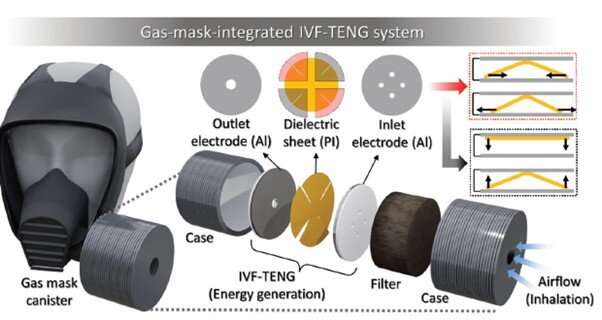Researchers breathe life into sensors with versatile gas masks

With the onset of the Internet of Things (IoT) era, devices have learned to communicate and exchange data. This is achieved through sensors installed in physical objects, machines, and equipment. The sensors can detect changes in events. However, the need for continuous energy supply to these sensors poses a challenge. Batteries are bulky, expensive, and not environmentally friendly. Additionally, they need to be constantly replaced or recharged.
Consequently, there is a demand for sustainable and renewable energy sources to replace batteries. The triboelectric nanogenerator (TENG) is one such device. Put simply, TENGs convert mechanical energy into electrical energy. Their high energy efficiency, compatibility with readily available materials, and low cost make them a promising candidate for powering sensors.
Despite such advantages, however, current TENGs are limited by a low output current. But increasing the output current would require larger equipment, making it impossible to be used in small devices. Is there a way around this trade-off?
A research team led by Associate Professor Sangmin Lee from Chung-Ang University in Korea, has now addressed this issue. "Our lab is interested in high-power TENG design and TENG-based self-powered sensors. We sought to address the limitation of current TENGs so that they could be used to realize portable power sources in practice," says Dr. Lee, explaining his motivation behind the study, which was published in Advanced Energy Materials. The study will be featured on the front cover of the upcoming issue.
The team developed a novel device in their study called "inhalation-driven vertical flutter TENG" (IVF-TENG) that exhibits an amplified current output. "Respiration acts as a continuous mechanical input and can be used to operate TENGs. Film-flutter TENGs are such respiration-driven devices that can generate a continuous electrical output from an extremely small respiration input by exploiting the flutter phenomenon arising from airflow-induced vibrations," explains Dr. Lee.
The IVF-TENG is composed of an aluminum (Al) inlet electrode, an aeroelastic dielectric sheet (polyimide), and an Al outlet electrode. The aeroelastic sheet has four segments with four slits and is subjected to vertical flutter behavior caused by airflow. This makes the proposed IVF-TENG different from existing TENGs.
The team investigated the electrical and mechanical mechanisms of IVF-TENG. They found that IVF-TENG generated a continuous, high-frequency electrical voltage (17 V) and a closed-circuit current of 1.84 μA during inhalation, and an electrostatic discharge voltage of 456 V and closed-circuit output current of 288 mA at the beginning and end of every inspiratory cycle.
They further demonstrated that IVF-TENG can continuously power 130 LEDs in series and 140 LEDs in parallel in every inhalation. Additionally, it could charge a 660 ?F capacitor to, in turn, power a Bluetooth tracker and provide its signal to a smartphone. These properties demonstrated the potential for IVF-TENG's application in portable electronics and wireless data transmission.
Furthermore, the researchers integrated IVF-TENG into a gas mask and demonstrated its ability to monitor the breathing pattern of the user by observing the output response waveform. Moreover, it could detect chemical warfare agents like cyanogen chloride, sarin, and dimethyl methylphosphonate (DMMP), showing its potential for use during emergencies. "Since gas masks are extensively used in emergencies like fire and chemical gas exposure, we focused on applying TENG to a gas mask. We believe that IVF-TENG can be used as a self-powered sensor in such scenarios," Dr. Lee says.
More information: Deokjae Heo et al, Inhalation‐Driven Vertical Flutter Triboelectric Nanogenerator with Amplified Output as a Gas‐Mask‐Integrated Self‐Powered Multifunctional System, Advanced Energy Materials (2022). DOI: 10.1002/aenm.202201001




















